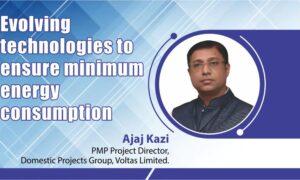“Energy efficiency – we call it as an improvement measure.”
A very informative information is – there’s a quite a lot, which we can segregate between pre pandemic and post pandemic and there are a lot of topics. So, I have got about four important topics. When we’re talking about transforming buildings into a performing asset, the first and foremost, which I would refer to is about how we can have buildings in terms of not more than just assets, but as now competitive ones, which we call it as the new competitive edge.
Energy efficiency, the new competitive edge
And these buildings are not only related to our offices and factories and other infras, but also important in terms of organisation goals, related to sustainability. The reputation of the organisation is also now linked to the buildings and is the centre of the sustainability topic because as we all know; the buildings consume 70 percent of the energy bill which we’re talking about. For example, in phone, you know there is an impact of about 30 percent is additional energy that could have been saved. The energy efficiency today is important and related to organisation reputation. So, this is what we call it as a new competitive edge.
The employee wellbeing is also associated to the new millennials who come to work today. They also get to ask in terms of what kind of buildings are – where do they work. So, these are something that today building is getting much more important than to the earlier ones which were more with related to passive asset, but today these buildings are talking to us and as much as understanding which we have related to the building – it can transform into value.
Performance of building
Second point for each building is different. We cannot have one size fits all. I have an energy optimisation solution; can I apply it to all the buildings! No. Every building has its own requirement, the end user may be different, the requirements of those buildings are different, the aging of those buildings is different. The infrastructure, for an example, is related to the people who occupy and those buildings are different.
So, it is important that the overall energy efficiency; we call it as improvement measure, are different from building to building and it is never a one size fits all, is the second important aspect highlighted and globally, if you look at on how this is managed, you know experts are looking at in terms of combining both the advanced technology and also the data, about the buildings talking to us. To arrive at a comprehensive solution, which means every building needs to be assessed, yes, the data needs to be compiled, but at the same time, the requirement and need of a building is different. So, that is where the experts are today working hard to ensure that each of those building needs is met.
So, that is the second aspect related to how we make the buildings performance.
Data analytics is the new fuel
In today’s world, how do we understand the way the building is talking to us and convert that into value is what is more important, because the right data is what will lead to you in the right direction and in data analytics language, the buildings is also no different. And what here we are talking about is – when we combine the data with the power of expertise, it can help us illustrate in terms of not only about saving; not only about reducing the operational costs; not only about how much am I saving on the bill; but it also will help you in terms of attracting tenants renegotiate in terms of your assets what is being consumed. And more importantly, what happens is, you know benchmark of your building, as simple as say for an example, how much optimisation, we are able to bring in with related to your building, and how is your building different, related to the sustainability aspect is important, and for which the data is the key, while we always call the data is the new fuel.
But I would say the most important aspects related to the data analytics, which can help us to bring in the efficiency of the building. Hence, the third important aspect is how we understand the data-these buildings bring into us.
Fourth aspect is green building
When we talk about the compliance, as in terms of what needs to be done in today’s building, it is also important that we take this particular aspect beyond the compliance – as in terms of how do we build value around all the sustainability topics, because across countries globally, there is a goal which is related to, you know, reducing the carbon footprint.
And at the same time, it is also important while we reduce on the energy efficiency or say for example, how do we improve the overall performance of the building? It’s important that how can the overall expenditure today, which I mean, why to upgrade a building, can pay for itself? It implies, how does the return on investment gets in?
And importantly, what do I have that relates to my offering in the sense: for an example – ageing of the building is an important aspect as well as integrating the latest technology, but how do we bring in both these worlds together is what is important, not just about reducing the operations. Or say, bringing down the equities, but it is also important, how strategically am I going to slow down the asset depreciations! Let’s take a chiller for an example. And we spoke about these 30 percent of extra energy which we pay for those aspects, but it also equals in terms of my equipment being consumed a lot, in the sense, that for unlimited set point which we are talking about, we have the mechanical equipment consuming more energy in terms of not only power, but also aging of the equipment is increasing.
So, in addition to reducing energy costs, it is also important – how we can make the building attractive; how the occupancy rate can be improved; how the relevance of it, can be achieved. These are the four important and decisive parameters.
Cookie Consent
We use cookies to personalize your experience. By continuing to visit this website you agree to our Terms & Conditions, Privacy Policy and Cookie Policy.















